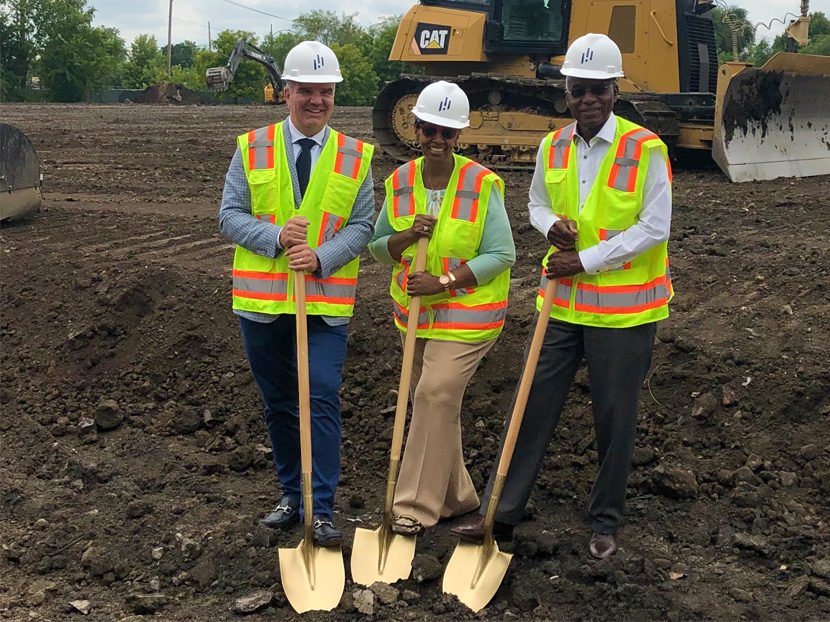Q&A with MIFAB President Michael Whiteside
MIFAB embarks on a 68,000-square-foot expansion to keep up with demand.

In 2018, MIFAB President Michael Whiteside realized the company had outgrown its 60,000-square-foot Chicago headquarters. The plumbing manufacturer needed more room for inventory to keep up with a steady increase in sales, so Whiteside and the rest of his team embarked on a 68,000-square-foot building expansion.
Now in its final stages, the expansion will allow the company to focus on three key product initiatives in 2020 and beyond:
• Quick Hub couplings
• BEECO backflow preventers
• Plastic grease interceptors
We sat down with Whiteside shortly after the building’s groundbreaking ceremony last summer to discuss these initiatives, how the company maintains successful relationships with key players, and what else is in store for MIFAB’s future.
Q: Can you tell us what is special about each of the three product initiatives this expansion is focused on?
MW: Quick Hub couplings, BEECO backflow preventers, and plastic grease interceptors are volume and space consuming. After considering their current and future growth, that’s what led to the need for the expansion.
We’re first-to-market on the Quick Hub coupling, and we have two patents on it. It provides about 40 percent labor savings for the contractor installing couplings onto cast iron pipe vs. the standard coupling. All of the market feedback we’ve been receiving from contractors is that they love the product, because their number one issue today is labor and not being able to get enough qualified labor. Once we started getting the reaction that we did from contractors on the Quick Hub, I realized that we needed the expansion.
For the BEECO backflow preventers, we received the USC approval last year. That gave us access to the entire U.S. market for the large USC-approved BEECO backflow preventers.
They need a lot of space for testing and assembly. I looked down the road four to five years and I thought, “We’re going to be doing a lot more BEECO backflow preventer business than we are now with this approval of USC, so we need to bulk up or we’re going to have space limitations.” It’s the USC approval and the unique stainless steel design that we have on the backflow that is creating the interest on that product.
For the plastic interceptors, we’re seeing a general trend away from steel and toward plastic because plastic doesn’t rust and it’s lighter weight. So, restaurant owners are realizing that they will get a longer lifetime experience with a plastic interceptor vs. a steel one, which corrodes in anywhere from five to 10 years depending on the conditions. We’ve invested a lot in a complete range of plastic interceptors from seven-gallon a minute all the way up to 2,000-gallon liquid holding capacity. That business is really growing, and again they take up a lot of room.
Q: What new physical spaces does this expansion create and what will they allow you to do?
MW: When it comes to the USC approval for BEECO backflow preventers, it’s a rigorous, strict standard that is very difficult to pass — as it should be because it’s protecting the public water supply. So, in the new building, we’ve dedicated an area that’s going to have a reservoir of water with a pump system so we can recirculate through the valves and mimic the lifecycle test and the backpressure test that the USC lab does in-house. We’ll be able to catch things that aren’t right before we send the product to the lab. We’ll be able to see performance in advance. I’m expecting that test lab is going to reduce the amount of time that it takes us to get the next generation of backflow to market.
Q: Is there any other new technology that this expansion will host?
MW: In terms of design of the building or equipment that’s going into the building, we are installing our HydroMax siphonic roof drains. Siphonic roof drains are about three times more efficient than regular roof drains. There are only three roof drains in our expansion, and that compares to gravity drains, which we would need about eight. We call that a technology because there’s a whole sizing program around how to size the siphonic roof drains relative to the roof design. We’ll be featuring that in this new building so we can show engineers and contractors a real, working building that has these drains installed when they visit.
Q: How do you build your relationships with specifiers?
MW: When we talk to specifiers, we like to make sure we’re adding value to them and their clients. For example, the International Plumbing Code changed its requirements for sizing roof drains. We were very proactive to communicate those changes to the engineering community, letting them know what happened, here’s why it happened and here’s the MIFAB solution to this new code change. Keeping them up to date with changes to code is a very important thing, as well as showing the engineer a value proposition in terms of the quality or versatility of the product so that their clients can realize the benefits of using our products.
Q: What are the main advantages for distributors who choose to stock your product lines?
MW: One of the big advantages is that we have a culture of continuous improvement. We’re always thinking about how to improve our products and how to improve our services to customers. We’re a relatively small, flexible company to listen to what our customers needs are and to do the best we can to accommodate. We’re also privately owned, so we’re not part of a large conglomerate or corporation. That gives us a longer-term view relative to inventory levels and fill rates.
Then with our drain design, we have a very unique modular system that makes it easier for a wholesaler to stock because there are fewer parts needed to make the whole assembly. We call it GMROI (Gross Margin Return on Inventory Investment). Because of our design, we can increase the wholesaler’s margins by not needing as many parts as others. Since our parts are multifaceted and do more than one function, there is physically less inventory that a wholesaler needs to stock with our product versus others. So, they get the best of both worlds with a gross margin improvement and a return on inventory investment with not having as many dollars tied up in stock.
Q: Are there any other current product categories you’re keeping an eye on in terms of growth?
MW: The specification drainage category is really seeing some nice growth. We’ve been fortunate to align ourselves with manufacturers reps who have had prior experience in the drain business. That takes up a lot of space too, so it’s a good thing that we’re moving into this new space soon.
Q: Are there any new products on the horizon for MIFAB?
MW: We have an automatic recovery grease interceptor. It’s a stainless steel device. There are certain parts of the country that require the automatic removal of the grease from the interceptor within the kitchen. Because we’re in the interceptor space, it makes sense for us to expand into that category. But, the big focus over the next several years is going to be growing those three main product initiatives — the BEECO Backflow, the Quick Hub and the plastic interceptors. We have a long runway in all those categories of many, many years of growth because we’re basically starting at zero. So, that’s going to keep us busy for a long time.
Q: Do you have any other long-term goals in mind?
MW: Our focus is our engineered products that require certification testing and have a value proposition to the engineer and to the owner. Products that fit that mold are the ones that we’ve expanded into recently and that we would continue in the future. Siphonic roof drains are still a very small share of the North American roof drainage market, whereas they’re a dominant share in Europe. We’re seeing a lot of growth in that category. It’s really an exciting product to promote because it saves costs for the owner and space for the architect/engineer. It is also environmentally friendly because it’s using a lot less material, roughly half the pipe length and diameter. So, that’s a nice technical, innovative product that’s getting a lot of attention.
Q: What do you attribute to the overall success of MIFAB?
MW: It has to be taking care of the customer and listening to what the customer wants. The manufacturers reps who represent us are critical and extremely important in communicating to us what they’re hearing from contractors, engineers and wholesalers. That’s really helped us to be open minded and aware of things that we need to continually improve upon.
Q: What does seeing this project come to fruition mean to you on a personal level?
MW: It’s really satisfying. It’s really amazing because I think about how MIFAB USA started in Toronto in 1993 out of 2,500 square feet. Once this building is done, we’ll be at 128,000 square feet. It is amazing to look back and think about how all that progress has occurred. Without the good, hardworking people we have, we certainly would not have had the success we’ve had as a company. I just get this great sense of fulfillment of working with a really nice team of people at MIFAB and growing the business through product expansion and improvement. It’s a challenge and it’s never easy, but it’s a lot of fun. l





